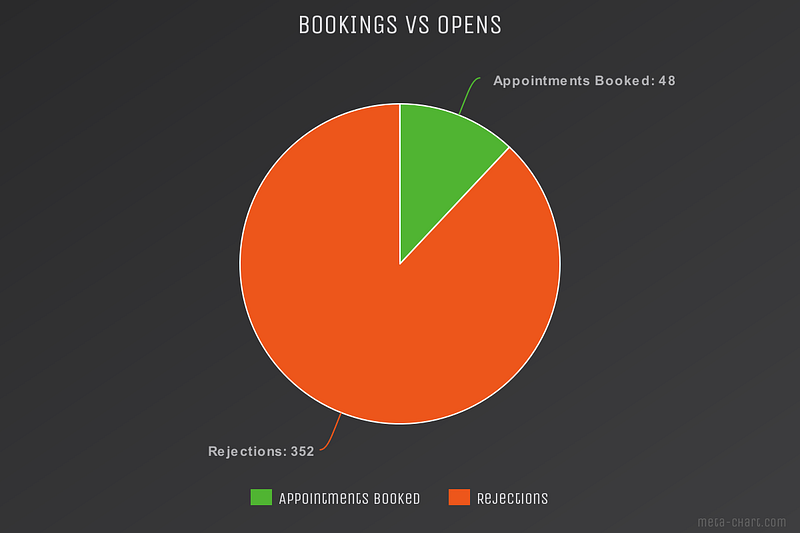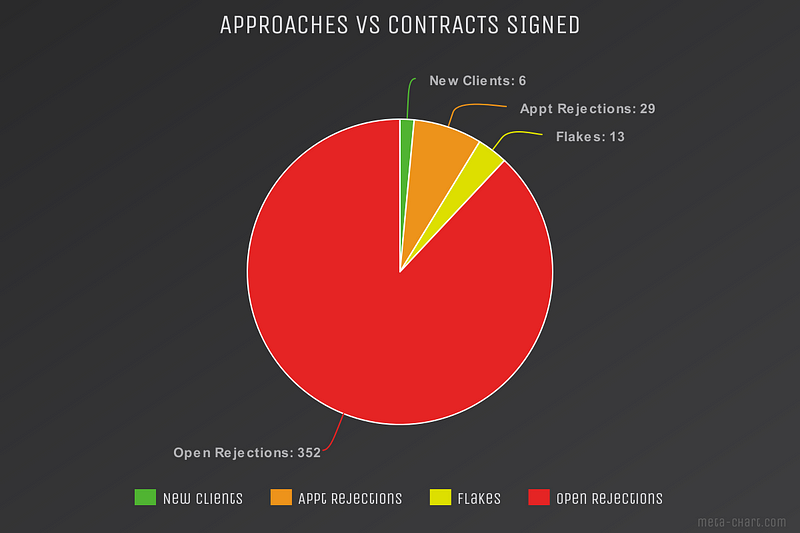Ah, sales. The mystical art of making money fall out of the sky and into my wallet.
For some reason, I’ve always been great at it. I’ve always closed deals significantly more often than my coworkers, and sales jobs for me have always been, to be honest, pretty easy to excel at.
Honestly, though, sales can be a giant pain. Prospecting, qualifying, filling up “the pipeline” — all of it is tough work. If it didn’t make me as much money as it does, it’s likely I’d have stopped doing it a long time ago. But that’s life, I suppose. The toughest things are usually the most fruitful.
Anyway, story time. I was recently forced back into selling because of a series of interesting career decisions. These decisions left me in charge of sales for a brand-new digital marketing agency and zero billable clients. With costs mounting, I realized I had to take drastic action if I wanted to dig the business out of this hole of debt.
So I fell back on my one real strength: selling stuff. I went all in, crafted a simple outside sales campaign, and approached 400 businesses in 10 days to sell my services. Here’s what happened.
The Pipeline
First step was figuring out my pipeline. I looked at what other agencies around me were doing, combined it with some of my past outside sales experience, and settled on an aggressive two-step campaign.
- Step One was the ~60 second cold open — going door to door and introducing myself to local businesses. My KPI was the number of appointments booked, which led to…
- Step Two, which was the appointment pitch. I scheduled these for “15 minutes”, but we always inevitably went over. One of my prospective clients sat with me for literally three hours once, so let that be a testament to how rigorous I was at keeping a proper schedule. My KPI here was the number of deals closed — I would go for the contract at the end of my pitch.
I focused on two principles: simplicity (I didn’t want anything elaborate for a one-man sales operation), and quick turnaround. My goal was to go from introducing myself to a signed contract within one week.
Speaking of contracts… I structured mine so that it was low pressure and month-to-month. Looking back, I probably would have had better client retention if I made it three-months (90 days) up-front, and then month to month afterward, but hindsight is always 20/20. The gist of my services were:
- Social Media Management
- Pay Per Click Advertising
- SEO
- Consulting & Strategy, and
- Website Design (for extra cost)
All in all, actual marketing workload was approximately 3 hours a week per client, minus set-up time and website design. I kept the starter package at $799, and ideally planned on upgrading clients to a $1299 package in the future.
Because of my desperation, I ended up creating custom-fit plans on more than one occasion for particular clients. If I could go back in time, I wouldn’t have done this since I think it decreased client trust. I believe it’s always better to be firm on prices and project an air of abundance (even if you, like me, started with a whopping zero clients) than to make one-off compromises for particular people.
The Process
The actual sales process took ten days total. I went door-to-door, M-F, from 11am–3pm for two weeks straight. Occasionally I had to break for appointments, but I mostly stuck to this schedule. Some days I had a friend of mine (who was selling similar IT products) come with me to amp both of us up and keep me accountable.
My Step One pitch was something like this:
Hi, how’s it going?
I’m not actually here to buy anything — I’m Nick, what’s your name?
Hey X. I’m actually here because we just set up shop a few blocks down the street — we’re a digital marketing agency called XYZ Digital — and I just wanted to meet you, shake your hand, and start building a relationship.
I’m setting up presentations for next Wednesday. They’re 30 or so minutes — fun and easy — where I walk you through a couple of things you guys are doing great in terms of your marketing, and a couple of things you guys could improve to drive in a few more people through that door.
What’s the calendar looking like for next week?
Hint: their calendar was almost always “very busy”. So busy, in fact, that out of 400 businesses, I only received two instant-yeses. But that’s to be expected in any outside sales venture. Any monkey can memorize a short, 30 second script — the real challenge is in being able to effectively handle customer objections.
My mentality on objections is very black-and-white. If they don’t give me some explicit variation of “yes, let’s do this”, or “no I don’t want this, please leave” then I keep pushing. My concern handling skills are strong enough that I can almost always logically deconstruct any other objection, like so:
Too busy? No problem, we’re local so we can always drop by — how’s next Thursday sound?
You don’t do online marketing? That’s awesome because if you’ve made it here without any digital so far, that shows me you guys are already really trusted in your space and there’s a lot of room to multiply those leads. Why don’t I show you how on Wednesday?
You need to talk to your partner first? Great, feel free to bring him to the meeting — that way we can all find out whether we’re a good fit together. When is he typically around?
And so on, and so on. After two or three of these faux-no’s, they usually step up to the plate and assert what they really want: a yes or a no. In my case, 400 opens resulted in 352 “no”s, and 48 “yes”es.

Of course, a handful of those rejections were aggressive; things like “get out now and stop soliciting”. This is to be expected any time you enter another person’s private space, and I understand that. But of special note is that almost all of the other 350 rejections were kind and respectful — I made several good business connections, met a dozen or more semi-interested business owners, and almost always left with hearing a permutation of “thank you for stopping by! See you soon.”
And I always, whether they liked me or not, left my card. Because next time they think about digital marketing, whether it’s in a week or even a full year from now, I want them to think about me.
My Step Two pitch was long, and most of it was improvised on the day-of. It’s tough to explain the minutiae — I leveraged a lot of my old sales experience and negotiating skills — but the general pitch had four stages.
- Hello; I introduced myself, made some jokes, and built some rapport through emotional spikes. I also introduced the agency & our work.
- Questions; I asked them a series of questions to qualify purchasing power and determine their specific needs.
- Unique value proposition; I gave them a short explanation as to why my services provide a custom-fit to the needs elucidated in the previous stage, and how I’m different from other marketers they may be in contact with.
- Close; I offered the contract, and accepted payments through Square. In some cases, I booked a second appointment where I provided a unique payment plan custom-tailored to their particular financials.
This was my four-step pitch, and I stuck to it almost every time. I’m a big believer in sticking to a process, and it ensured that I always knew where I was going, as well as approximately how much longer I needed to be in that room with them.
Of course, not all pitches went well. In fact, most performed relatively poorly. Out of the 48 appointments I booked, 13 canceled or flaked, and 29 ultimately did not sign on with me. But I don’t worry about the ones that didn’t — I worry about the ones that did.
Because out of those 48 appointments, we received 4 sterling new clients. 4 clients that jumpstarted the agency and allowed me to take a break from the oh-so-dreadful process of selling, and focus on what I really like to do: digital marketing.

Lessons
My journey isn’t special. 4 out of 400 equates to a 1% conversion rate — this actually turns out to be within standard success margins for the industry (anywhere from 0.5%–2%). The main thing I want you to take away from my ten-day struggle is that outside sales still works. Cold calling, door-to-door, and cold emails are still a viable business strategy; you just have to stick to a process and learn not to be fazed by rejection.
Inbound marketing behemoths like HubSpot will try and convince you that outbound is dead, and that your time is better spent curating a content calendar or segmenting your email list for the zillionth time. Sure, you may see a significant ROI on both of these tasks, but I contend that the real reason so many people are migrating their businesses to full inbound is that it’s easier. Because they don’t have to put their confidence, or their pride, on the line.
I make no suggestions as to the contrary in this article — sales is still rough. It’s annoying to say the same thing four hundred times in a row, it’s cold going door-to-door (especially in the winter months), and it’s practically ego suicide to hear the word “no” day-in and day-out for weeks. But, in life, it’s the things that suck to do that usually lead to the most self-growth and success. And I’ll venture to say we could all use a bit more of both in our lives.



